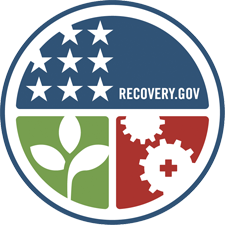Grading the New Recovery.gov

Recovery.gov relaunched yesterday, and we’ve spent some time playing around with the site since then. The verdict? Well, it’s hard to say — the site’s a bit broken. There are 404s all over the place, most gallingly on the data download page. Parts of the site seem like they work, but don’t: the select boxes on the front page that provide filters for the map don’t actually affect its behavior in any way. It’s hard to see these glaring bugs alongside the totally-unnecessary link to Facebook and not groan (am I supposed to play Scrabble with Chairman Devaney?).
That ESRI map is clearly the centerpiece of the site, and it’s nice enough, though I confess I’m still figuring out how to use it. It also makes the odd decision of plotting contracts by the recipient’s location, not the location of the project itself. For instance, I found a contract plotted in Lovell, WY. But the work was performed across the state in Cheyenne, on Warren Air Force Base — it’s just that the contractor is based in Lovell. There’s a case to be made for each type of view, but the vagaries of corporate organization would’ve led me to make a different choice. At the very least, being able to switch would be nice.
The most important thing to note is that there’s less new stuff here than it might seem. At the moment the site just aggregates information from USASpending.gov, FedBizOpps.gov, Grants.gov, fpds-ng.com, and recovery-specific agency reports that were already available on the old Recovery.gov. Recipient reporting — and with it subrecipient data, job creation information and other good stuff — won’t be arriving until mid or (more likely) late October. The current site should therefore be thought of as an attempt to filter existing information and make it comprehensible to a general audience, not as something wholly new.
So does it succeed in this effort? To some extent I think it does, bugs notwithstanding. Having contracts and grants on the same map is a step forward. The record detail pages may be disappointing to some, but I’ve worked directly with the same underlying data and can say with confidence that the Recovery.gov team has done a decent job of making the best of a bad situation. This glossary could be displayed a lot more prominently, but it’s a useful and welcome document.
Still, I’ve been looking at FAADS and FPDS data for months as part of my work on Subsidyscope, so all of this sort of makes sense to me. I’m not sure that a new visitor to the site is going to understand why some dollar amounts are negative, or what the difference is between an obligation and a contract with exercised options. Some of this complexity is unavoidable — the bookkeeping systems of the largest government on earth are inevitably going to be complicated! But I have to believe that more could’ve been done to make the information understandable. And given the lack of genuinely new information, I would’ve liked to see the new Recovery.gov make more headway on this front. It’s no longer enough to shove data at the public, then call it a job well done when the audience walks away in a state of complacent confusion.
Which brings us back to limiting the criteria by which we judge the site. Is it a perfect tool for tracking recovery dollars? No, not really. But the limits of the legacy systems it was built upon made that goal unrealistic from the start — Recovery.gov was never going to solve the data quality problems of USASpending, for instance. But it is a step toward making those systems comprehensible, and perhaps setting the stage for improving them — or it can be, at least. So kudos for that.
We’ll certainly be keeping an eye on Recovery.gov as the October data release draws closer. Have any of you had a chance to check out the site? What do you think?

